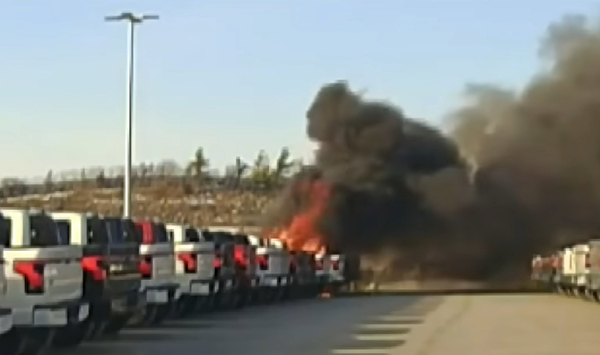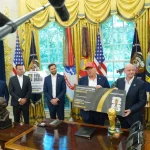
(function(d, s, id) { var js, fjs = d.getElementsByTagName(s)[0]; if (d.getElementById(id)) return; js = d.createElement(s); js.id = id; js.src = “https://connect.facebook.net/en_US/sdk.js#xfbml=1&version=v3.0”; fjs.parentNode.insertBefore(js, fjs); }(document, ‘script’, ‘facebook-jssdk’)); –>
–>
August 10, 2023
The following essay is satire, but the Biden administration’s push for the creation of an Electric Combat Vehicle and the requirement for handicapped spaces at each charging station (wherever they may be) are real.
‘); googletag.cmd.push(function () { googletag.display(‘div-gpt-ad-1609268089992-0’); }); document.write(”); googletag.cmd.push(function() { googletag.pubads().addEventListener(‘slotRenderEnded’, function(event) { if (event.slot.getSlotElementId() == “div-hre-Americanthinker—New-3028”) { googletag.display(“div-hre-Americanthinker—New-3028”); } }); }); }
With the desire of the Biden Administration to push the military into using renewable energy and electric vehicles wherever possible, field testing of the Army’s new Electric Combat Vehicle (ECV) began in May of 2024. The first six, each costing $227,000, were built on the chassis of the Ford F-150 Lightning battery-powered pickup truck. They were delivered to Aberdeen Proving Ground in Maryland for testing.
Hard bumps on test tracks ruptured two of the batteries. Within seconds the electrolytic fluid in them erupted into flames that the fire department was unable to extinguish.
After that testing, Army Public Affairs issued a glowing press release about how well the four surviving ECVs had performed while not mentioning the two charred hulks that had to be dealt with by Hazmat crews.
‘); googletag.cmd.push(function () { googletag.display(‘div-gpt-ad-1609270365559-0’); }); document.write(”); googletag.cmd.push(function() { googletag.pubads().addEventListener(‘slotRenderEnded’, function(event) { if (event.slot.getSlotElementId() == “div-hre-Americanthinker—New-3035”) { googletag.display(“div-hre-Americanthinker—New-3035”); } }); }); }
In July, ECV testing moved to Fort Irwin, California, to see how they performed in intense desert heat. Four new ECVs were added to the fleet. Within hours of being driven off-road in the trackless desert, they began to experience a high rate of tire failures that slowed their travel.
Those high temperatures also sharply increased the pressure in the batteries until one battery casing ruptured, and all the test team could do was stand back and watch the unquenchable flames turn it into a charred wreck.

Image: Electric trucks in flames at a Ford plant. YouTube screen grab.
In compliance with Biden’s rules, a pair of million-dollar EV charging stations had been built. It didn’t matter that they were 27 miles from the nearest paved road. They were powered by a full acre of solar panels installed on the habitat of the protected desert tortoise.
In compliance with the strict Biden rules, the charging stations included asphalt-paved and blue-striped handicap-only parking spaces in front of the chargers. When the test team arrived, they found that the intense heat of the sun had turned the asphalt into a sticky, molten goo.
More than that, the charging cables were too short to reach each vehicle’s charging port without parking in the handicapped slot, so the test director told his team to park there anyway. They shoveled dirt onto the asphalt goo so the drivers could get in and out without getting their shoes or vehicle stuck.
Once connected, they discovered that the solar panels couldn’t charge both vehicles at the same time in the required 90 minutes. To survive the ambient heat during the recharging period, the test team retreated to the air-conditioning in their petroleum-powered rides.
‘); googletag.cmd.push(function () { googletag.display(‘div-gpt-ad-1609268078422-0’); }); document.write(”); googletag.cmd.push(function() { googletag.pubads().addEventListener(‘slotRenderEnded’, function(event) { if (event.slot.getSlotElementId() == “div-hre-Americanthinker—New-3027”) { googletag.display(“div-hre-Americanthinker—New-3027”); } }); }); } if (publir_show_ads) { document.write(“
As they put a second pair of vehicles on the chargers, they heard the sound of a Security Police helicopter. It circled before landing nearby, but not for a friendly “Hello.”
The security officers checked the two vehicles being recharged, saw that neither had the proper handicap license tag or handicap marker hanging from the non-existent rearview mirror and proceeded to write the test director a pair of parking violations for unauthorized vehicles in handicapped spaces.
The team leader protested that what they were doing was ludicrous, but his words fell on deaf ears. He could pay his fines of $258 each or hope the judge bought his protest. On his day in court, the judge sympathized but said the law was the law, and he wasn’t allowed to dismiss the tickets.
By the time testing finished at Ft. Irwin, two more ECVs had become charred hulks when their batteries ruptured, apparently from thermal expansion of the electrolytic fluid in them. Both were revealed by flames as they turned into scrap metal. The test team was so far out in the desert that all they could do was move away and watch them burn.
Despite these problems, Army Public Affairs issued another glowing press release telling how great the ECVs had performed.
In late September, the testing was handed over to the Army and moved to Fort Wainwright, Alaska, for what was supposed to be a month of testing under the harsh conditions of the arriving Arctic winter.
Six new EVs were delivered, giving Master Sergeant Eric Wolford and his 26-member team a total of eleven Electric Combat Vehicles to test. During the summer, the Army had spent more than $2 million for a contractor to build a solar charging station with four chargers and nearly five acres of solar panels along with the required asphalt handicap-only parking spaces, even though they were out in the Alaskan wilds some 76 miles from the nearest paved road.
After days of preparation, the group started out at first light. Getting to the charging station took them most of the short day, and what they found was troubling. Two of the chargers could not be used because, apparently, a bear had taken a liking to the taste of the charging cable insulation, rendering them unrepairable.
That reduced their charging capacity to just two ECVs at a time. While the solar panels gave them enough energy to charge within 90 minutes, they quickly ran out of daylight, so recharging would have to finish in the morning. MSgt. Wolford radioed back that they would remain at the charging stations until all vehicles were charged before continuing to their next objective, a multi-million-dollar second charging station built even farther from civilization.
The weather turned ominous and, on Day Four of their wait at the charging station, a major winter storm reduced visibility to near zero. With minimal sunlight, all charging stopped.
The storm prevented air evacuation, so the soldiers shifted into survival mode and hunkered down in their shelters. By morning, there were two feet of snow all around them, burying the two acres of solar panels. More was falling with no end in sight. Nothing could be recharged, and the cold, now below zero, quickly reduced what charge was on the replenished ECV batteries to zero.
On the second night, the soldiers ran out of the diesel fuel they had brought for their heaters so, to keep from freezing to death, they asked MSgt. Wolford for permission to rupture a couple of the ECV batteries so the flames could be used to keep them warm.
With appropriate concern for the welfare of his soldiers, he told them to go ahead. Within minutes the soldiers had exposed the first two batteries. They beat on them with whatever tools they had to try to rupture the casings. Soon the flames pushed back cold and saved their lives.
Another day would pass before rescue helicopters could find and evacuate the soldiers. When they arrived, six of the ECVs were charred hulks.
MSgt. Wolford submitted his report and, within days, received notice that he was being suspended from duty and notified that he was being charged with four felonies for the willful destruction of government property along with four counts of parking an unauthorized vehicle in a handicapped space.
At his court-martial, MSgt. Wolford’s defense was that he and his troops were in a desperate situation where their survival was at stake, so they had done what they could just to survive. The judge agreed and dismissed the felony charges. However, the judge was unable to dismiss the parking tickets, and MSgt. Wolford was forced to pay fines totaling more than a thousand dollars.
Peropus Consiliario is a pseudonym.
<!–
–>
<!– if(page_width_onload <= 479) { document.write("
“); googletag.cmd.push(function() { googletag.display(‘div-gpt-ad-1345489840937-4’); }); } –> If you experience technical problems, please write to [email protected]
FOLLOW US ON
<!–
–>
<!– _qoptions={ qacct:”p-9bKF-NgTuSFM6″ }; ![]() –> <!—-> <!– var addthis_share = { email_template: “new_template” } –>
–> <!—-> <!– var addthis_share = { email_template: “new_template” } –>





